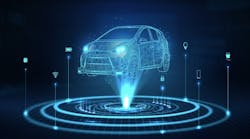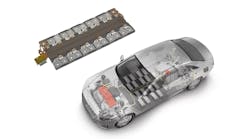Five ways auto companies can capture the consumer-driven transportation market
When a car shopper arrives at the automaker’s website, hoping to learn more about an intriguing new vehicle-by-subscription program, they are greeted by a headline touting an all-inclusive service that bundles an automobile with maintenance and insurance, all for one monthly fee.
“Subscribe online. No long-term commitment. The modern way to lease a car,” says the site.
Sounds enticing. But then another click reveals a catch: “Inventory is currently unavailable online,” says the site. Apparently, a promising new business model designed to appeal to consumers’ desire for a simplified car-buying and ownership experience has been complicated by supply chain issues. Instead of easily cruising through an online inventory of program cars, interested consumers are asked to check with their local dealer about vehicle availability. And when they do inquire, they may find that the model they want isn’t available, or that their local dealer has opted out of the program altogether.
Circumstances like these underscore the interconnected challenges that automotive companies are wrestling with in a marketplace rife with disruption as a result of advancing technology, surging interest in cleaner vehicles, shifting consumer-mobility preferences, and, of course, major supply chain bottlenecks.
To thrive amid all the disruption, automotive companies will need to find ways to innovate in five strategically critical areas:
1. The drive to sustainability. Consumers, regulators, policymakers and other stakeholders are sending a clear message to automakers: prioritize lower-carbon footprint, resource efficiency and circularity in the products and services you offer, and in how your entire value chain operates.
Not only are automakers facing heightened pressure to make their operations more sustainable, shifting policies and buying preferences are driving a major surge in demand for electric vehicles and other types of advanced drivetrains. In Europe, for example, EV sales reportedly are outpacing sales of diesel-powered vehicles for the first time ever, while demand for EVs also is surging in places like the US and China. Automakers are responding. Some, like Volvo and General Motors, already have committed to sell only zero-emission vehicles within the next 10-15 years. “Consumer expectations are clearly shifting to be more attuned to sustainability as a purchase decision criterion,” IDC analyst Reid Paquin observed.
The pressure to become more sustainable applies not only to the products automakers sell, but to their own operations and those of their value chain partners. Companies across the automotive industry are aligning around that common goal via initiatives like the Catena-X Automotive Network, an alliance whose member companies are collaboratively working toward carbon-reduction and other goals by developing uniform standards for data exchange up and down the automotive value chain through constructs like a shared digital twin. Providing recyclers with data to inform decisions on automotive component reuse, recycling and/or recovery strategies is among the focal points of the program.
Whether individually or as part of a business network, automakers have a golden opportunity to leverage their sustainability-related activities to gain a competitive edge. To do so, they’ll need the ability to trace materials, parts and components across the value chain, and to refine their internal processes to design and manufacture for sustainability across the entire product lifecycle.
2. Connected cars. While it may be some time before people can comfortably sit back and let their car do the driving, advances in connected-car and driver-assist systems are laying the groundwork for an eventual shift to autonomous transportation, while in the meantime enabling automakers to provide a richer, service-laden experience with—and within—their vehicles.
Building a cloud-based vehicle-to-everything (v2x) infrastructure driven by smart technologies like LIDAR and Internet of Things (IoT) sensors will help automakers and their value chain partners (dealers, service providers, etc.) collect and share data to create the kinds of entertainment, productivity and mobility services that customers want, and that can unlock new revenue streams, with the vehicle serving as the platform for delivering value-added services related to their vehicle (predictive maintenance, charge point availability and the like) and to their lifestyle (such as deals from partner vendors).
In this context, all stakeholders are part of a network built around the vehicle digital twin, and the data supplied by the connected vehicle becomes a valuable “emission” that helps companies shape and enrich the overall mobility experience for the end customer.
3. Mobility as a service and shared mobility. Speaking of experiences, “Getting closer to consumers and focusing on their needs will be the only way [for automotive companies] to succeed,” posited IDC’s Paquin. “Customer experience must become the new priority, and…mobility as a service (MaaS) is a growing topic that many in the industry have been considering to better differentiate themselves and grow into new markets.”
Recognizing that fewer consumers are interested in traditional car ownership, automakers are angling on the MaaS market via ventures such as Toyota’s Kinto, a subscription service for Uber, delivery and private drivers. New business models like these provide the flexibility and convenience that consumers and fleet operators increasingly expect.
4. Smart manufacturing, backed by a resilient supply chain. From EVs to personalized vehicle configurations and eventually to driverless cars, demand for a broader array of more complex vehicles is prompting auto manufacturers and their supply chain partners to shift away from traditional linear production approaches and investigate new ways to efficiently and profitably meet customer expectations. Modular manufacturing, in which vehicles and their components are built at various highly automated production “cells” within a factory, will be key to producing heterogeneous model mixes efficiently at scale, with the flexibility to adjust with consumer demand.
To support the evolution of manufacturing, automotive companies also need to build more resilient supply chain networks in which aligned companies make decisions based on real-time information. “Transformed automotive companies will create digital models of their supply chain that will not only report performance and current conditions but also enable accurate simulations of possible scenarios for extended planning,” said Paquin.
5. Customer-centricity. All this suggests that it’s time for automotive companies to reframe their strategic goals with an eye toward winning a larger share of a consumer’s “mobility wallet.” Doing so means gaining a thorough understanding of individuals, families and businesses, then developing value-added mobility solutions that create brand loyalty through a superior customer experience. Digital retailing options, such as contactless car buying via a frictionless omnichannel experience involving dealer, manufacturer and other service providers, could well be one of those solutions. Vehicle-by-subscription could be another.
Whichever routes automotive companies ultimately decide to travel, succeeding will depend on their ability to understand customers’ point of view and put their feedback at the center of every decision, from design and engineering, through manufacturing and sales, all the way to the in-vehicle experience.
By Thomas Pohl, global industry marketing lead for automotive at SAP SE


